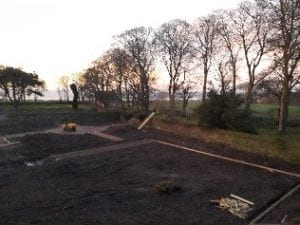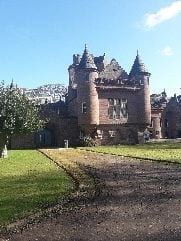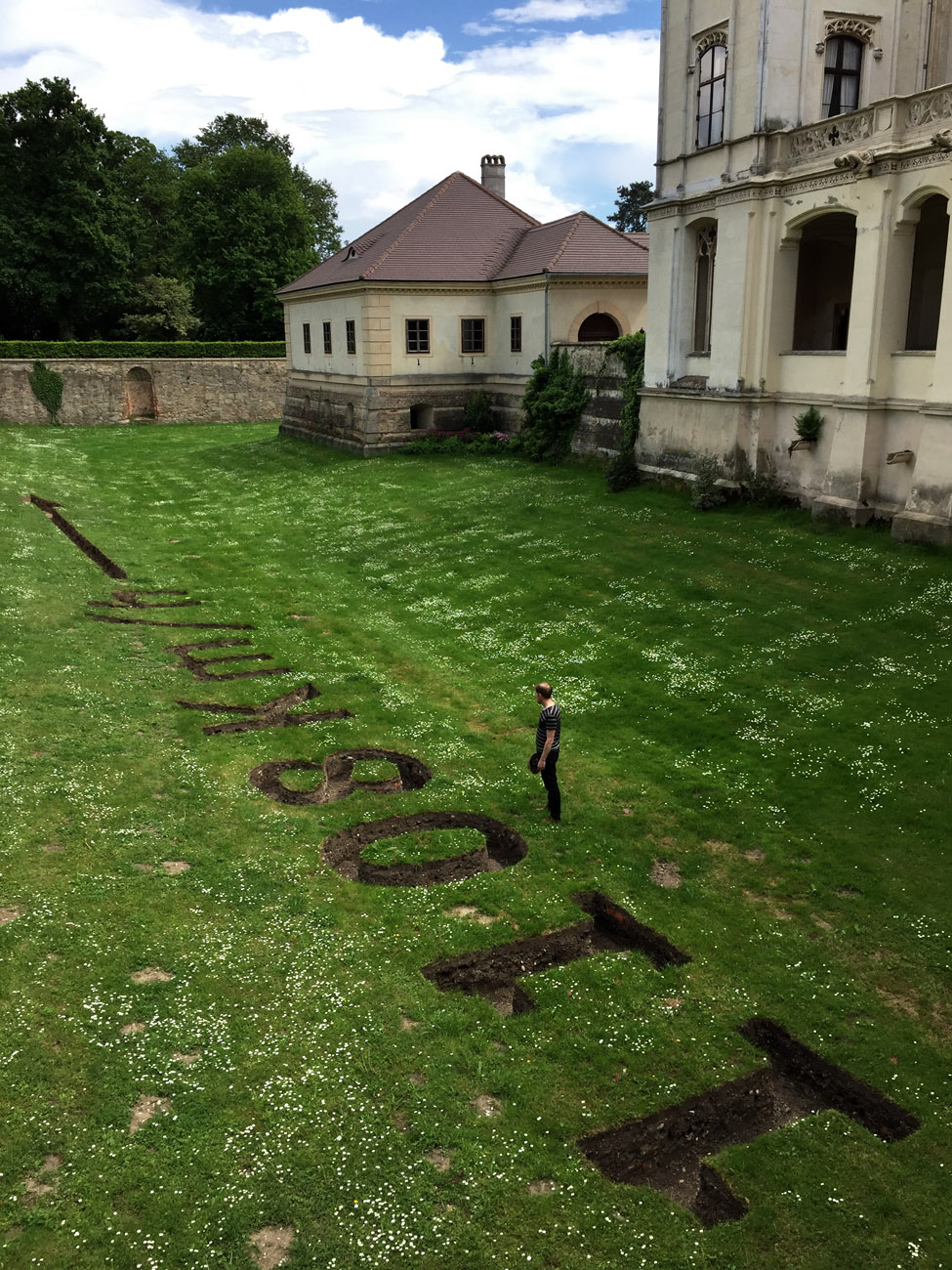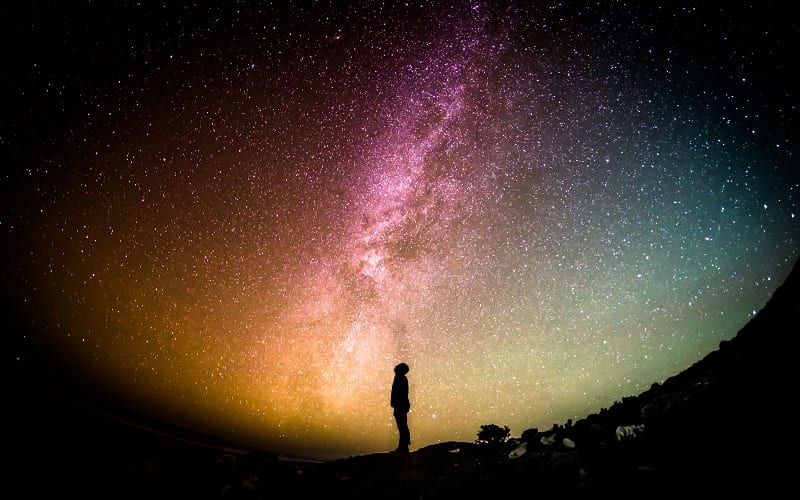Earth, by Nicola Baldwin
By ucsadje, on 27 September 2020
HOSPITALFIELD JOURNAL – ‘Woman From Mars’, writing the first draft
I’m writing this on 26 September, on the train from Arbroath, leaving Hospitalfield House, where I’ve just completed a two-week cross-disciplinary residency, which began on 16 March…. Cut short by lockdown, suspended for 6 months while the House was closed. The replanting of the garden allowed a trial reopening, and the last (lost) group were invited back.
I was there, thanks to an MGCfutures bursary, to write the first draft of ‘WOMAN FROM MARS’, about Helen Sharman, the first British Astronaut, who traveled to Mir space station in May 1991 on the final mission of the Soviet cosmonaut programme.
The play I’m now finishing has changed in several ways – including the title. Returning to Hospitalfield brought into focus what an intense, strange experience, that first residency delivered; the five of us, mostly alone in the house, washing and sanitising hands, doorknobs, kettles before touching, kettles after touching, trying to concentrate on our own work and wondering if the decision to come here would kill us. Some of us getting panicked emails, texts and calls from home, to come home – texts and emails from our jobs, not to come back.
I kept a journal as I planned to write the first draft over an 8-day burst, as a dramaturgical re-enactment of Sharman’s Soyuz TM-12 mission itself. On 23 March I returned to London and caught COVID on the trip. Crossing the Tay Bridge I shot a short video of the first morning of lockdown.
Nicola Baldwin, 26 March, (I’m crossing it again now)
‘WOMAN FROM MARS’ HOSPITALFIELD JOURNAL, Nicola Baldwin March 2020
My writing residency at Hospitalfield runs from Monday March 16 – Sunday 29 2020
Helen Sharman on Mir mission from Saturday May 18 (launch) 1991, returning May 26.
I am synching these notes on writing the first draft to same dates of month.

First Briton in space, cosmonaut Helen Sharman, May 1991.
Monday March 16 2020
The project of this fortnight is to write a first draft of a new play, while using the Interdisciplinary Residency to reflect on my practice. Firstly, by working through a schematic set of activities which foreground the process of dramatic creation and explore how structure and story interact; secondly, by talking with fellow Residents, visual artists, about their work. The first intent is informed by the 12 biological and chemical experiments Helen Sharman performed during her 8-day mission to Mir. The second intention, by the fact that as a playwright and scriptwriter, I work along the axis of time – narrative drama, whether live or recorded, is received in real time, and my practice resolves around creating temporary sequences of events. By using specific approaches to constructing narrative, and the opportunity to work in a large blank space I can make my working process spatial and visual. I will be able to ‘see’ how I work.
Tuesday March 17 2020 / MAY 17 1991
Helen Sharman: At Baikonur Star City. Eve of launch, packing final kit for experiments.
Me: At Hospitalfield Interdisciplinary residency. Unpacking notes and setting up workspace. Initial plot question. How to expand an existing short play, wherein the moments and dramatic twists are baked in. ‘Miss (Stella) Shaw’ is both integral, and problematic. She is literally an interloper, but will she split focus too much in the full draft? Initially drawn to frame story of another ‘Helen’ plucking up courage to tell her mum ‘Mrs Shaw’ about moving to Ukraine with ‘Sergei’ in 2021, with final twist of ‘Helen’ being schoolkid who received Mir seed from Helen Sharman. For about 24 hours this idea feels a quirky and dramatically bold way to tell my story. I’m trying to rationalise the existence of Miss Shaw in space to make the story about the transaction with Helen and Miss Shaw. Also to protect my play if the real Helen Sharman decides she really doesn’t want the play to happen… If I do have this double narrative frame; of Miss Shaw on Mir being the impetus for Helen to tell her story; this is turn framed by another ‘Helen’ whose story this really is…. We still don’t explain Miss Shaw. But it would be:
‘HELEN’ USES THE STORY OF HELEN SHARMAN MIR MISSION TO EXPLAIN TO HER MOTHER WHY SHE IS MOVING FOR NEW LIFE IN UKRAINE WITH ‘SERGEI’.
 Wednesday March 18 2020 / Saturday MAY 18 1991
Wednesday March 18 2020 / Saturday MAY 18 1991
Helen Sharman: Following various checks, medicals, rituals, successful launch Soyuz TM-12.
Me: Break down structure of existing short script onto post its and go through accumulated notes on current draft what needs to change, where to expand, what rings false. Read again sections of SEIZE THE MOMENT (Helen Sharman ghost-written autobiography) on the Mir Mission. Read again about the training and preparatory build up.
Get bogged down on tone / intent. Troubled by responsibility to my subject (Helen Sharman); the more I got to grips with her character, the more I understand why she wouldn’t approve my approach. I reject the (double) frame story, which coming into this residency seemed so appealing. The actual story of Helen Sharman is enough; stuffing it into a washing-up glove of kitchen sink drama is folly. Really I should be breaking it down. As Experiment 1, I approach the narrative in a ‘straight’ telling, powered by her character motivation and sketch a bash-draft of the story from a single premise….
I think of
HELEN SHARMAN ACCIDENTALLY HEARS AN AD FOR AN ASTRONAUT AND OVERCOMES MANY OBSTACLES TO REACH SPACE.
Or, even…
HELEN SHARMAN RESPONDS TO A RANDOM ADVERT FOR ASTRONAUT AND OVERCOMES MANY OBSTACLES TO ACHIEVE 6 DAYS OF WORLD PEACE ON MIR.
But… Sharman is not a dramatic character, however in order to tell the story ‘straight’ I need to dramatize her; i.e.. interpret her motives and invent obstacles (e.g. initial dislike between her and Sergei but in the end, she wins his respect; her being fearful and useless on initial Soyuz trip, floundering and the other 2 telling her to go away, before them ultimately bonding etc). I kind of think both these things may be true, but to tell the story this way requires narrative seeding, potentially more distorting of the ‘true’ experience than my existing framing device.
She’s rationalist, experimental, measured. An introvert with sense of fun with small groups of friends (at Star City); self-contained and happy alone. A typical scientist? Why does she apply? What does she want?
She’s curious. To see what its like, what would happen; to see if she can.
She loved sport, activity and, though she loved learning, hated much at school. Her mantra as a child, I Can Do It. Enjoys challenges. Yet introvert. Determined, and determinedly ordinary. An ordinary person who decided to have a go, and having decided, gave it her best shot. She’s very aware of gender in selection process, but determined others will not be, and won’t go there herself. She calculates her chances as a woman, without being a feminist. Factual response. Herself, as person with strengths. A unit.
 Thursday March 19 2020 / Sunday MAY 19 1991
Thursday March 19 2020 / Sunday MAY 19 1991
Helen Sharman: on Soyuz TM-12 travelling towards Mir. Regular work/ checklists. Busy.
Me: Wake up feeling terrible. Not physically but emotionally jangled. Been building inside me, or rather outside, the situation with COVID-19 pandemic which I have been furiously blocking out, invades my dreams and on waking up, my thoughts. I worry about home, about self-isolating in London if I even get back; about whether I should try and get to Yorkshire. Parts of last 2 days occupied emailing actors to confirm cancellations – THE DUCHESS, the Waste play, workshops for WOMAN FROM MARS, total closure of UCL. All this intrudes and writing anything starts to feel pointless. What’s the point of writing a play when theatre is in ruins? I commit to paying all the actors. Will I really get through this? Financially? Physically?
To calm myself and simply get something done I explore gaps in the story from existing short version. I do a timeline of her backstory from hearing ad until Soyuz mission itself, and go through details of her time on Mir, particularly the purpose and nature of her experiments.
As Experiment 2, I plot some basic dates around situation in Eastern Europe, collapse of Berlin Wall, of Soviet Union. In these stories, I find parallels with my uncertainty about the world outside, the empty shelves, paranoia, feeling of apocalypse. I think about Helen Sharman’s comment about learning Russian and why pointing at things not an option; ‘you might be able to go into a shop in Italy and point at a cheese, but after queuing for hours in Moscow snow to enter a shop where the shelves are empty, you have to be able to explain to the shop assistant what you are looking for’. I think again that Helen Sharman’s extraordinary achievement is not simply being selected as a Russian cosmonaut, but also living in Russia for 18months. Also, her constant assertions about being an ordinary person, from an ordinary family, with ordinary childhood – no longer seem just like covering her privacy. There’s almost something political about insistence, and I wonder if she appreciated the Soviet ideal of merit?
In the evening we screen THE TWO POPES film against the wall – written and directed by playwright turned screenwriter Anthony McCarten (THEORY OF EVERYTHING). It’s very like a play, but with enormous set pieces; Ratzinger’s character isn’t explored until we see him coming to believe Bergoglio should be his successor. It’s interesting for me being based on real people, and very recent history – reminding me how little we know of anything behind news headlines and what a pleasure it is to revisit this news/ history as story. Again the idea of approaching it straight; yet the flourishes of THE TWO POPES are the voice of the writer, the structure, choices and
McCarten’s pacing are what makes the film a success.
In my notebook I go over the old writing questions:
Investigate what you’re really writing. Your idea. What’s it about?
Human contact? Finding and losing oneself?
Whose story is it? What does she want? Why can’t she have it? What must she figure out?
WHO ARE YOU? WHAT IS YOUR THRESHOLD?
DO YOU STAND FOR THIS, OR SOMETHING ELSE?
 Friday March 20 2020 / Monday MAY 20 1991
Friday March 20 2020 / Monday MAY 20 1991
Helen Sharman: Arrival at Mir. Perilous docking, potentially catastrophic but dealt with. She experiences no fear because, from emergency training, took a measured view of risks.
Familiarises herself with radio ham equipment. Wrote at the time ‘Ace evening’.
Me: Today I get to grips with story, doing a bullet point list. My previous bullet list was always coming up with a ‘straight’ telling of events, because I was struggling to work through MISS SHAW as a consistent narrative. Now I take ownership of the story. It doesn’t matter what anyone might think, further down the line, what matters now is what I think. I decide my existing short version is broadly Act 1, though travel of characters through story is patchy. ‘Authenticity’ will come from working them in properly. The gaps and development needs to become the rest of the story. I think about where to put the launch sequence and the overall flow of visual set pieces. Then I think about what it means that this matters….
I fret about structure. For Experiment 3, I go back to Stephen Jeffrey’s book, and break the story as a 3 act structure – journey there, Mir, journey home. Jeffreys calls it the ‘magic trick’: Act 1 = The Pledge (an ordinary pen); Act 2 = The Turn (turn it into a bird and watch it fly off\) Act 3 = The Prestige (bird returns and turns back into a pen).
Jeffreys quotes David Edgar, that you can reduce every story to a single sentence, with a ‘but’. And if so, it’s:
HELEN SHARMAN DEFEATS EXTRAORDINARY OBSTACLES TO REACH MIR BUT DISCOVERS HER HARDEST CHALLENGE WILL BE COMING HOME.
That, marvellously, is exactly the story of the play. True to the situation and stakes of the drama, plus there is evidence of this in her accounts of Mir, where her most personal comments are about her reluctance to return to earth. So, it’s not the trivial fear of doing the broadcast to children, but what comes after, in the rest of her life, that is the final challenge?
The last thing I do is build a 3 Act structure with my post-its on 3 A2 sheets of paper, using the existing breakdown, some of the real timeline, and key notes for areas to expand.
After I’ve gone up to bed I set-up Experiment 4, a Myers-Briggs personality test for Helen Sharman, she comes out ISTJ, Introvert, Sensing, Thinking, Judging.
That night I also have an ending come to me as I am falling asleep, which doubles down on Miss Shaw, and leaves us with Sergei; for Helen appear back on Mir in his imagination, meeting Yuri Gagarin – who is not there either, but is Sergei’s version of Miss Shaw. I’m owning the bonkersness of my story, but also flipping it to say something about isolation. Not sure if this final twist will come out in the wash, but for today it gives me a light at the end of the tunnel.
Early next morning, I write:
Keep Stella Shaw, not as framing, but for character & human warmth
Expand and make truer Helen’s training and selection.
What real obstacles?
Soviet Union. Yuri Gagarin!
Blast Off later
It takes longer to conduct the experiments, they are contradictory. Results non-linear.
Her growing relationship with…? Miss Shaw?
Develop Anatoly – show this later?
Take seriously the final conversation with Sergei
Danger of return.
Remember that, Anatoly returned at the end of his mission as planned, 5 after months. Sergei had to remain aboard Mir, since the nation responsible for returning him to earth, the USSR, had ceased to exist. Newspapers round the world dubbed Sergei, ‘the last Soviet citizen’. People wondered how he would survive the solitude, which in the end, after 8 months, was the longest (then?) of any human in space. Treadmill. Helen – meet Yuri.
All life is chemistry and the people we meet, places we go, things we do, change us.
 Saturday March 21 2020 / Tuesday MAY 21 1991
Saturday March 21 2020 / Tuesday MAY 21 1991
Helen Sharman: First full day’s work. Time suddenly feels short. Goes looking for cameras and trying to locate and set up her various experiments on the crowded Mir space station.
Me: I wake up feeling really positive. It’s our first day (as residents) alone in the House. Thursday was my when time started feeling short, when I was panicking I should be elsewhere. Today, time feels under control. I plot out the Myers-Briggs ideas from last night – Experiment 4 – and am pleased and surprised, that under this system, Helen is:
HELEN – ISTJ – INTROVERTED, SENSING, THINKING, JUDGING
Quiet, serious, earn success by thoroughness and dependability. Practical, matter-of-fact, realistic, and responsible. Decide logically what should be done and work toward it steadily, regardless of distractions. Take pleasure in making everything orderly and organized – their work, their home, their life. Value traditions and loyalty.
After my initial victory over my time, I allow myself to fully occupy my (work)space. I disassemble the 3 Acts from paper and use the long bare wall to begin assembling the whole sequence of the play as a single line, loosely as 3 Acts. For the first time I see the play spread out.
I’ve still really only got an Act 1, but the shape of the rest is clearer, and what I need to fill the gaps with is lurking, unsorted, among the post-its and timelines on the other wall.
All I need to do is to work on those ideas with felt emotion, to make them cross the room.
I think about the ‘shape’ of the dramatis personae; the relationship between Helen and Sergei. That crucial conversation on the final night; his conversation with Musa and Viktor before their departure home. I think I am finally constructing an engine to make the play fly – though I still don’t know where to.
I’m not totally convinced by my 3 Acts, because I know the launch needs to be my mid-point – visually, sculpturally – and I am interested to unpick how I know this, because it is anti-chronological, and suggests a deeper image system, as if crystalised fragments of the ‘real’ play are forming in the mix and bubbling to the surface. I need more sense of stakes and decision, in order to increase the boil. It’s the same problem as before, that real life is not narrative, and though Sharman’s story absolutely fits every element of story I need her to embody, I need to translate this into beats of personal obstacles, poor choices and failures which she overcomes, not let them simply be circumstance. This will include her interaction with other characters. I don’t feel I can develop those interactions clearly until I work out what I want them to do.
I plan Experiment 5, to test for archetypal structure, using 7 Basic Plots (Christopher Booker). I think about Quests. I remind myself that, in an archetypal Quest:
The Call Kickstarts the plot and gives the hero a mission to accomplish.
The Journey over enemy territory, obstacles pop up left and right; monsters (kill/escape), temptations, a rock and a hard place or journey to the underworld.
Arrival and Frustration She’s so close! She can see the Emerald City! Oh, wait, the Wizard won’t help them until they kill the Wicked Witch of the West. Still some work to do.
The Final Ordeals Now the final tests. A set of three? She is the only one who can complete the final test. Success! An amazing escape from ‘death’.
The Goal she has completed quest and gets treasure/ prince/ trip home. Holy Grail.
It’s not exactly how my story will play out, but looking at it as a quest, something clicks into place. I add Quest beats into my basic 3 Acts. The challenge now – and the exact place I should be at this point in my 8-day ‘Mission’– is determining the significance of any chunks of history and material I am putting in; placing them to make the story resonate.
If I continue the Quest Experiment, into characters, I discover that she needs:
- A close friend who loyal to our hero, but doesn’t have much else going for him or her;
- A sidekick who is polar opposite of the hero mentally, physically, and emotionally;
- A balanced party of brains, heart, and strength who support the hero, or who count the hero as one of their own.
In the short version I made Sergei her friend and ally. I toyed with the idea of making him an adversary whose respect she wins, rejecting this for being presumptive, but I think there’s probably truth in it. Certainly for the story, his authority is essential. In the short version he’s like a sidekick, but they are more similar than opposite. From her writings, its clear that Anatoly (‘Tolya’), who started training at the same time, and learning English as she was learning Russian, is her sidekick in the mission – not the remote, comic character he was in my short version. I decide – without any reference to his actual personality and traits – to see what happens if I make him the polar opposite of Helen’s Myers-Briggs, and it comes out as:
TOLYA – ENFP (HER OPPOSITE) EXTROVERT, INTUITIVE, FEELING, PERCEIVING
Warmly enthusiastic and imaginative. See life as full of possibilities. Make connections between events and information very quickly, and confidently proceed based on the patterns they see. Want a lot of affirmation from others, and readily give appreciation and support. Spontaneous and flexible, often rely on their ability to improvise and their verbal fluency.
Helpfully, and remarkably, this chimes with everything Helen has said about Tolya – right down to his keenness to practice English, and instances of him improvising fixes on board.
For Sergei, I pick the personality type of a Commander wherein his Myers-Briggs would be:
SERGEI – ENTJ (CONNECTS THEM) EXTROVERT, INTUITIVE, THINKING, JUDGING
Frank, decisive, assume leadership readily. Quickly see illogical and inefficient procedures and policies, develop and implement comprehensive systems to solve organizational problems. Enjoy long-term planning and goal setting. Usually well informed, well read, enjoy expanding their knowledge and passing it on to others. Forceful in presenting their ideas.
What’s useful about this, is that I’m sticking close to Helen’s own descriptions of herself and what people have said about her, to create a character based on her authentic personality. I’m then ‘making up’ the personalities of Sergei and Tolya to fit the needs of the plot – and yet, these character profiles feel accurately lifelike. It’s not surprising, given the efforts the Soviet cosmonaut programme put into personality testing, that they would aim to ‘design’ each Soyuz mission crew with the best fit of personalities to enable team-working. If so, interesting that the space programme is making similar choices to the needs of narrative?
Miss Shaw, at this stage, doesn’t need a Myers-Briggs as she’s not really there, and for the Quest structure, she is the ‘close friend’ who is ‘loyal to our hero, but doesn’t have much else going for him or her’ (sorry, Miss Shaw).
The tricky thing will be making my finale-heavy structure play out in the real timeline. But I think that’s where the emotional impact of the short version was, and will be, still Her final ordeal is a personal acceptance of, and struggle to, leave Mir to return home. Perhaps her obstacles are: winning Sergei’s respect, making her peace with death, coming home (both personal and personally dangerous). The final reward will come with Yuri Gagarin, but she needs to take that respect home with her.
 Sunday March 22 2020 / Wednesday MAY 22 1991
Sunday March 22 2020 / Wednesday MAY 22 1991
Helen Sharman: Sets up and begins working through a series of 12 experiments; biological, chemical, crystallographic, photographic.
Me: Having built the structure and reorganised existing scenes, I start writing. I do a couple of hours before breakfast working through Act 1. The aim being to write in stages continuously for the next 4 days, following the time in which Helen Sharman is conducting the major experiments, winding up on 26th when she returned to earth.
I do a load of laundry go for a walk. Sit on my bedroom balcony in the sunshine drying laundry on a rack. After the draft is finished I hope to visit the beach before I go back home.
In the afternoon, the residency is halted because of the deteriorating situation over COVID-19. I peel off my post-its and drawings and ‘disappear’ my play from my workroom walls.
I go in my room, lie on the bed, and cry my eyes out….
That night Camilla, Fiona, Kirsteen and I eat dinner (Grace having left in the afternoon). The log stove is burning in the sitting room and we sit talking on our last night.

Nicola Baldwin sketch of Mir based on Helen Sharman diagram
Monday March 23 2020 / Thursday MAY 23 1991
Helen Sharman: Working through the experiments. Breaks off for live interview on TV am as Mir passing over UK.
Me: This is the day I part company with Helen Sharman, and head back down to earth. I wake up at half five and carry a chair onto the balcony up the cramped spiral steps from my room, to watch the sun rise. I think about space. The moon and earth. I think about ‘Overview’; Jeeva from UCL Outer Space Research Centre questioned Overview as a myth, despite some anecdotes from cosmonauts and astronauts about seeing our blue planet from space, being life-changing; it’s simply something the general public want to believe it true. I wonder about Helen Sharman’s last night on Mir, talking late with Sergei while the Sun rose and set rapidly during the circuit of an orbit. We know they talked about the journey back to earth, which is always more dangerous than launch and arrival. Perhaps they talked about the fact that Viktor and Musa – who would be returning with Helen on Soyuz TM-11, were making their first re-entry 5 months after they had trained for it, and that Helen – more recently trained in emergency protocols – would have a vital role to play, far beyond the responsibility of maintaining experiments on board. From what Helen Sharman has said of that conversation, it feels like she came to an acceptance of the possibility of death. That we all die, and cosmonauts are trained only for emergencies that are survivable, not how to prepare for those that aren’t.
We have breakfast together. Camilla sets off walking to the station, as the first to leave.
I remember a conversation with Fiona this week, on the relative merits of trying to force through a plan of work in a residency, or being open to what happens. Fiona – like Helen Sharman, a chemist by training – said that you can’t control what will happen or how you will feel, all you can do is observe the results.
Fiona packs her car and Kirsteen gets aboard for a lift to Glasgow. I wonder how Sergei Krikalev felt, as the Soviet Union vanished beneath him and the cosmonaut programme ground to a halt; no Soyuz crew could relieve them. Anatoli returned to earth in the final Soyuz. Sergei remained on board to maintain Mir. When he might return, no one knew.
I wave the others off in the sunshine and think of an interview with the senior psychologist at Star City, in which he said that if cosmonauts go into space and do not get along, when they return to earth they never talk to each other again; yet when cosmonauts on a mission get along well, they are friends for life.
The End?
I wrote this on the almost deserted 10.49 Arbroath to London train, 23 March 2020, the first day of national lockdown.
 Wednesday March 25 2020 / Saturday MAY 25 1991 (London)
Wednesday March 25 2020 / Saturday MAY 25 1991 (London)
Helen Sharman: The 24th and 25th May were the two days in which I completed most of my work.
Me: These are the days I had intended to blitz-write the draft at Hopsitalfield based on the structures I had mapped out. Since arriving back in London on Monday night, I took yesterday off – to go out and buy food and get ready for the social distancing measures, until I can get back to Mir, and hope to use the next few days of isolation as a continued residency to finish the script roughly on schedule.
Nicola Baldwin, 25/3/2020
Thanks to my fellow Residents:
Camilla Brueton, Fiona McGurk, Grace Maran, Kirsteen Macdonald
Also:
Lucy Byatt, Hospitalfield Director
Cicely Farrer, Programme Manager
 Close
Close









